Supercritical Carbon Dioxide(s-CO2) Power Cycle for Waste Heat Recovery: A Review from Thermodynamic Perspective
Abstract
1. Introduction
2. Barriers to Waste Heat Recovery
3. State-of-the-Art Thermodynamic Cycles for Waste Heat Recovery
4. Advances in s-CO2 Power Cycles for Waste Heat Recovery
4.1. Fuel Cell
4.2. Internal Combustion Engine
4.3. Gas Turbine
4.4. Others
5. Further Perspectives
6. Conclusions
Author Contributions
Funding
Conflicts of Interest
References
- Formann, C.; Muritala, I.; Pardemann, R.; Meyer, B. Estimating the global waste heat potential. Renew. Sustain. Energy Rev. 2016, 1, 1568–1579. [Google Scholar] [CrossRef]
- Xu, Z.; Wang, R.; Yang, C. Perspectives for low-temperature waste heat recovery. Energy 2019, 176, 1037–1043. [Google Scholar] [CrossRef]
- Lu, H.; Price, L.; Zhang, Q. Capturing the invisible resource: Analysis of waste heat potential in Chinese industry. Appl. Energy 2016, 161, 497–511. [Google Scholar] [CrossRef]
- Hong, G.; Pan, T.; Chan, D.; Liu, I. Bottom-up analysis of industrial waste heat potential in Taiwa. Energy 2020, 198, 117393. [Google Scholar] [CrossRef]
- Yong, Z.; Bashir, M.; Ng, C.; Sethupathi, S.; Lim, J.; Show, P. Sustainable waste-to-energy development in malaysia: Appraisal of environmental, financial, and public issues related with energy recovery from municipal solid waste. Processes 2019, 7, 676. [Google Scholar] [CrossRef]
- Galanis, N.; Cayer, E.; Roy, P.; Denis, E.; Désilets, M. Electricity generation from low temperature sources. J. Appl. Fluid. Mech. 2009, 2, 55–67. [Google Scholar]
- Sun, F.; Li, J.; Fu, L.; Li, Y.; Wang, R.; Zhang, S. New configurations of district heating and cooling system based on absorption and compression chillers driven by waste heat of flue gas from coke ovens. Energy 2020, 193, 116707. [Google Scholar] [CrossRef]
- Hsua, C.; Lin, T.; Liang, D.; Lai, C.; Chen, S. Optimization analysis of waste heat recovery district cooling system on a remote island: Case study Green Island. Energy Convers. Manag. 2019, 183, 660–670. [Google Scholar] [CrossRef]
- Liao, G.; Jiaqiang, E.; Zhang, F.; Chen, J.; Leng, E. Advanced exergy analysis for Organic Rankine Cycle-based layout to recover waste heat of flue gas. Appl. Energy 2020, 266, 114891. [Google Scholar] [CrossRef]
- Lin, S.; Zhao, L.; Deng, S.; Ni, J.; Ma, M. Dynamic performance investigation for two types of ORC system driven by waste heat of automotive internal combustion engine. Energy 2019, 169, 958–971. [Google Scholar] [CrossRef]
- Wang, M.; Deng, C.; Wang, Y.; Feng, X. Exergoeconomic performance comparison, selection and integration of industrial heat pumps for low grade waste heat recovery. Energy Convers. Manag. 2020, 2071, 112532. [Google Scholar] [CrossRef]
- Han, X.; Zou, H.; Jiang, W.; Tian, C.; Huang, G. Investigation on the heating performance of the heat pump with waste heat recovery for the electric bus. Renew. Energ. 2020, 152, 835–848. [Google Scholar] [CrossRef]
- Johnson, I.; Choate, W.; Davidson, A. Waste Heat Recovery. Technology and Opportunities in US Industry; BCS, Inc.: Laurel, MD, USA, 2008. [Google Scholar]
- Zhai, H.; An, Q.; Shi, L.; Lemort, V.; Quoilin, S. Categorization and analysis of heat sources for organic Rankine cycle systems. Renew. Sustain. Energy Rev. 2016, 64, 790–805. [Google Scholar] [CrossRef]
- Manente, G.; Toffolo, A.; Lazzaretto, A.; Paci, M. An Organic Rankine Cycle off-design model for the search of the optimal control strategy. Energy 2013, 58, 97–106. [Google Scholar] [CrossRef]
- Quoilin, S.; Aumann, R.; Grill, A.; Schuster, A.; Lemort, V.; Spliethoff, H. Dynamic modeling and optimal control strategy of waste heat recovery organic Rankine cycles. Appl. Energy 2011, 88, 2183–2190. [Google Scholar] [CrossRef]
- Wang, T.; Zhang, Y.; Zhang, J.; Peng, Z.; Shu, G. Comparisons of system benefits and thermo-economics for exhaust energy recovery applied on a heavy-duty diesel engine and a light-duty vehicle gasoline engine. Energy Convers. Manag. 2014, 84, 97–107. [Google Scholar] [CrossRef]
- Pandis, P.; Papaioannou, S.; Siaperas, V.; Terzopoulos, A.; Stathopoulos, V. Evaluation of Zn- and Fe-rich organic coatings for corrosion protection and condensation performance on waste heat recovery surfaces. Int. J. Therm. Fluid. 2020, 3, 100025. [Google Scholar] [CrossRef]
- Li, M.; Tang, S.; Wang, F.; Zhao, Q.; Tao, W. Gas-side fouling, erosion and corrosion of heat exchangers for middle/low temperature waste heat utilization: A review on simulation and experiment. Appl. Therm. Eng. 2017, 126, 737–761. [Google Scholar] [CrossRef]
- Lei, B.; Wu, Y.; Ma, C.; Wang, W.; Zhi, R. Theoretical analyses of pressure losses in organic Rankine cycles. Energy Convers. Manag. 2017, 153, 157–162. [Google Scholar] [CrossRef]
- Hipólito-Valencia, B.; Rubio-Castro, E.; Ponce-Ortega, J.; Serna-González, M.; Nápoles-Rivera, F.; El-Halwagi, M. Optimal integration of organic Rankine cycles with industrial processes. Energy Convers. Manag. 2013, 73, 285–302. [Google Scholar] [CrossRef]
- Stijepovic, M.; Linke, P. Optimal waste heat recovery and reuse in industrial zones. Energy 2011, 36, 4019–4031. [Google Scholar]
- Dou, Y.; Togawa, T.; Dong, L.; Fujii, M.; Ohnishi, S.; Tanikawa, H.; Fujita, T. Innovative planning and evaluation system for district heating using waste heat considering spatial configuration: A case in Fukushima, Japan. Resour. Conserv. Recycl. 2018, 128, 406–416. [Google Scholar] [CrossRef]
- Li, C.; Wang, H. Power cycles for waste heat recovery from medium to high temperature flue gas sources—From a view of thermodynamic optimization. Appl. Energy 2016, 180, 707–721. [Google Scholar] [CrossRef]
- Poullikkas, A. An overview of current and future sustainable gas turbine technologies. Renew. Sustain. Energy Rev. 2005, 9, 409–443. [Google Scholar] [CrossRef]
- Chen, Y.; Lundqvist, P. The CO2 transcritical power cycle for low grade heat recovery-discussion on temperature profiles in system heat exchangers. In Proceedings of the ASME 2011 Power Conference (POWER2011), Denver, CO, USA, 12–14 June 2011. [Google Scholar]
- Boewe, D.; Bullard, C.; Yin, J.; Hrnjak, P. Contribution of internal heat exchanger to transcritical R-744 cycle performance. HVAC&R Res. 2001, 7, 155–168. [Google Scholar]
- Marcus, Y. Some Advances in Supercritical Fluid Extraction for Fuels, Bio-Materials and Purification. Processes 2019, 7, 156. [Google Scholar] [CrossRef]
- Bae, S.; Lee, J.; Ahn, Y.; Lee, J. Preliminary studies of compact Brayton cycle performance for small modular high temperature gas-cooled reactor system. Ann. Nucl. Energy 2015, 75, 11–19. [Google Scholar] [CrossRef]
- Bell, L. Cooling, heating, generating power, and recovering waste heat with thermoelectric systems. Science 2008, 321, 1457–1461. [Google Scholar] [CrossRef]
- Lee, S.; Yang, Y.; Lee, H.; Ghasemi, H.; Kraemer, D.; Chen, G.; Cui, Y. An electrochemical system for efficiently harvesting low-grade heat energy. Nat. Commun. 2014, 5, 3942. [Google Scholar] [CrossRef]
- Duan, J.; Feng, G.; Yu, B.; Li, J.; Chen, M.; Yang, P.; Feng, J.; Liu, K.; Zhou, J. Aqueous thermogalvanic cells with a high Seebeck coefficient for low-grade heat harvest. Nat. Commun. 2018, 9, 5146. [Google Scholar] [CrossRef]
- Pandya, S.; Wilbur, J.; Kim, J.; Gao, R.; Dasgupta, A.; Dames, C.; Martin, L. Pyroelectric energy conversion with large energy and power density in relaxor ferroelectric thin films. Nat. Mater. 2018, 17, 432. [Google Scholar] [CrossRef] [PubMed]
- Feher, E. The supercritical thermodynamic power cycle. Energy Convers. Manag. 1968, 8, 85–90. [Google Scholar] [CrossRef]
- Siddiqui, M.; Taimoor, A.; Almitani, K. Energy and Exergy Analysis of the S-CO2 Brayton Cycle Coupled with Bottoming Cycles. Processes 2018, 6, 153. [Google Scholar] [CrossRef]
- Siddiqui, M.; Almitani, K. Energy Analysis of the S-CO2 Brayton Cycle with Improved Heat Regeneration. Processes 2019, 7, 3. [Google Scholar] [CrossRef]
- Siddiqui, M.; Almitani, K. Energy and Exergy Assessment of S-CO2 Brayton Cycle Coupled with a Solar Tower System. Processes 2020, 8, 1264. [Google Scholar] [CrossRef]
- Mehrpooya, M.; Esfilar, R.; Moosavian, S. Introducing a novel air separation process based on cold energy recovery of LNG integrated with coal gasification, transcritical carbon dioxide power cycle and cryogenic CO2 capture. J. Clean. Prod. 2017, 42, 1749–1764. [Google Scholar] [CrossRef]
- Khaw, K.; Shaw, P.; Parat, N.; Pandey, S.; Falconer, J. Compound identification and in vitro cytotoxicity of the supercritical carbon dioxide extract of papaya freeze-dried leaf juice. Processes 2020, 8, 610. [Google Scholar] [CrossRef]
- Sánchez, D.; Chacartegui, R.; Jiménez-Espadafor, F.; Sánchez, T. A new concept for high temperature fuel cell hybrid systems using supercritical carbon dioxide. J. Fuel Cell Sci. Technol. 2009, 6, 021306. [Google Scholar] [CrossRef]
- Sanchez, D.; de Escalona, J.; Chacartegui, R.; Munoz, A.; Sanchez, T. A comparison between molten carbonate fuel cells based hybrid systems using air and supercritical carbon dioxide Brayton cycles with state of the art technology. J. Power Sources 2011, 196, 4347–4354. [Google Scholar] [CrossRef]
- Bae, S.; Ahn, Y.; Lee, J.; Lee, J. Various supercritical carbon dioxide cycle layouts study for molten carbonate fuel cell application. J. Power Sources 2014, 270, 608–618. [Google Scholar] [CrossRef]
- Baronci, A.; Messina, G.; McPhail, S.; Moreno, A. Numerical investigation of a MCFC (molten carbonate fuel cell) system hybridized with a supercritical CO2 Brayton cycle and compared with a bottoming organic rankine cycle. Energy 2015, 93, 1063–1073. [Google Scholar] [CrossRef]
- Ahmadi, M.; Mohammadi, A.; Pourfayaz, F.; Mehrpooya, M.; Bidi, M.; Valero, A. Thermodynamic analysis and optimization of a waste heat recovery system for proton exchange membrane fuel cell using transcritical carbon dioxide cycle and cold energy of liquefied natural gas. J. Nat. Gas Sci. Eng. 2016, 34, 428–438. [Google Scholar] [CrossRef]
- Mahmoudi, S.; Ghavimi, A. Thermoeconomic analysis and multi objective optimization of a molten carbonate fuel cell–Supercritical carbon dioxide-Organic Rankin cycle integrated power system using liquefied natural gas as heat sink. Appl. Therm. Eng. 2016, 107, 1219–1232. [Google Scholar] [CrossRef]
- Ryu, J.; Ko, A.; Park, S. Thermo-economic assessment of molten carbonate fuel cell hybrid system combined between individual sCO2 power cycle and district heating. Appl. Therm. Eng. 2020, 169, 114911. [Google Scholar] [CrossRef]
- Shu, G.; Shi, L.; Tian, H.; Li, X.; Huang, G.; Chang, L. An improved CO2-based transcritical Rankine cycle (CTRC) used for engine waste heat recovery. Appl. Energy 2016, 176, 171–182. [Google Scholar] [CrossRef]
- Shu, G.; Shi, L.; Tian, H.; Deng, S.; Li, X.; Chang, L. Configurations selection maps of CO2-based transcritical Rankine cycle (CTRC) for thermal energy management of engine waste heat. Appl. Energy 2017, 186, 423–435. [Google Scholar] [CrossRef]
- Shu, G.; Li, X.; Tian, H.; Shi, L.; Wang, X.; Yu, G. Design condition and operating strategy analysis of CO2 transcritical waste heat recovery system for engine with variable operating conditions. Energy Convers. Manag. 2017, 142, 188–199. [Google Scholar] [CrossRef]
- Shi, L.; Shu, G.; Tian, H.; Chang, L.; Huang, G.; Chen, T. Experimental investigations on a CO2-based Transcritical Power Cycle (CTPC) for waste heat recovery of diesel engine. Energy Procedia 2017, 129, 955–962. [Google Scholar] [CrossRef]
- Li, X.; Shu, G.; Tian, H.; Shi, L.; Huang, G.; Chen, T.; Liu, P. Preliminary tests on dynamic characteristics of a CO2 transcritical power cycle using an expansion valve in engine waste heat recovery. Energy 2017, 140, 696–707. [Google Scholar] [CrossRef]
- Li, X.; Shu, G.; Tian, H.; Huang, G.; Liu, P.; Wang, X.; Shi, L. Experimental comparison of dynamic responses of CO2 transcritical power cycle systems used for engine waste heat recovery. Energy Convers. Manag. 2018, 161, 254–265. [Google Scholar] [CrossRef]
- Shi, L.; Shu, G.; Tian, H.; Chen, T.; Liu, P.; Li, L. Dynamic tests of CO2-Based waste heat recovery system with preheating process. Energy 2019, 171, 270–283. [Google Scholar] [CrossRef]
- Shi, L.; Tian, H.; Shu, G. Multi-mode analysis of a CO2-based combined refrigeration and power cycle for engine waste heat recovery. Appl. Energy 2020, 264, 114670. [Google Scholar] [CrossRef]
- Shu, G.; Wang, R.; Tian, H.; Wang, X.; Li, X.; Cai, J.; Xu, Z. Dynamic performance of the transcritical power cycle using CO2-based binary zeotropic mixtures for truck engine waste heat recovery. Energy 2020, 194, 116825. [Google Scholar] [CrossRef]
- Liu, P.; Shu, G.; Tian, H.; Feng, W.; Shi, L.; Wang, X. Experimental study on transcritical Rankine cycle (TRC) using CO2/R134a mixtures with various composition ratios for waste heat recovery from diesel engines. Energy Convers. Manag. 2020, 208, 112574. [Google Scholar] [CrossRef]
- Choi, B. Thermodynamic analysis of a transcritical CO2 heat recovery system with 2-stage reheat applied to cooling water of internal combustion engine for propulsion of the 6800 TEU container ship. Energy 2016, 107, 532–541. [Google Scholar] [CrossRef]
- Sharma, O.; Kaushik, S.; Manjunatti, K. Thermodynamic analysis and optimization of a supercritical CO2 regenerative recompression Brayton cycle coupled with a marine gas turbine for shipboard waste heat recovery. Therm. Sci. Eng. Prog. 2017, 3, 62–74. [Google Scholar] [CrossRef]
- Hou, S.; Zhang, F.; Yu, L. Optimization of a combined cooling, heating and power system using CO2 as main working fluid driven by gas turbine waste heat. Energy Convers. Manag. 2018, 178, 235–249. [Google Scholar] [CrossRef]
- Manjunath, K.; Sharma, O.; Tyagi, S.; Kaushik, S. Thermodynamic analysis of a supercritical/transcritical CO2 based waste heat recovery cycle for shipboard power and cooling applications. Energy Convers. Manag. 2018, 155, 262–275. [Google Scholar] [CrossRef]
- Liang, Y.; Bian, X.; Qian, W.; Pan, M.; Ban, Z.; Yu, Z. Theoretical analysis of a regenerative supercritical carbon dioxide Brayton cycle/organic Rankine cycle dual loop for waste heat recovery of a diesel/natural gas dual-fuel engine. Energy Convers. Manag. 2019, 197, 111845. [Google Scholar] [CrossRef]
- Feng, Y.; Du, Z.; Shreka, M. Thermodynamic analysis and performance optimization of the supercritical carbon dioxide Brayton cycle combined with the Kalina cycle for waste heat recovery from a marine low-speed diesel engine. Energy Convers. Manag. 2020, 206, 112483. [Google Scholar] [CrossRef]
- Liang, Y.; Sun, Z.; Dong, M.; Lu, J.; Yu, Z. Investigation of a refrigeration system based on combined supercritical CO2 power and transcritical CO2 refrigeration cycles by waste heat recovery of engine. Int. J. Refrig. 2020, 118, 470–482. [Google Scholar] [CrossRef]
- Pan, M.; Bian, X.; Zhu, Y.; Liang, Y.; Lu, F.; Xiao, G. Thermodynamic analysis of a combined supercritical CO2 and ejector expansion refrigeration cycle for engine waste heat recovery. Energy Convers. Manag. 2020, 224, 113373. [Google Scholar] [CrossRef]
- Zhang, R.; Su, W.; Lin, X.; Zhou, n.; Zhao, L. Thermodynamic analysis and parametric optimization of a novel s–CO2 power cycle for the waste heat recovery of internal combustion engines. Energy 2020, 209, 118484. [Google Scholar] [CrossRef]
- Song, J.; Li, X.; Wang, K.; Markides, C. Parametric optimisation of a combined supercritical CO2 (S-CO2) cycle and organic Rankine cycle (ORC) system for internal combustion engine (ICE) waste-heat recovery. Energy Convers. Manag. 2020, 218, 112999. [Google Scholar] [CrossRef]
- Walnum, H.; Neksa, P.; Nord, L.; Andresen, T. Modelling and simulation of CO2 (carbon dioxide) bottoming cycles for offshore oil and gas installations at design and off-design conditions. Energy 2013, 59, 513–520. [Google Scholar] [CrossRef]
- Moroz, L.; Burlaka, M.; Rudenko, O.; Joly, C. Evaluation of gas turbine exhaust heat recovery utilizing composite supercritical CO2 cycle. In Proceedings of the International Gas Turbine Congress, Tokyo, Japan, 15–20 November 2015. [Google Scholar]
- Cho, S.; Kim, M.; Baik, S.; Ahn, Y.; Lee, J. Investigation of the bottoming cycle for high efficiency combined cycle gas turbine system with supercritical carbon dioxide power cycle. In Proceedings of the ASME Turbo Expo 2015: Turbine Technical Conference and Exposition, Montréal, QC, Canada, 15–19 June 2015. Article No. 43077. [Google Scholar]
- Huck, P.; Freund, S.; Lehar, M.; Peter, M. Performance comparison of supercritical CO2 versus steam bottoming cycles for gas turbine combined cycle applications. In Proceedings of the 5th International Symposium on Supercritical CO2 Power Cycles, San Antonio, TX, USA, 29–31 March 2016. [Google Scholar]
- Wright, S.; Davidson, C.; Scammell, W. Thermo-economic analysis of four sCO2 waste heat recovery power systems. In Proceedings of the 5th International Symposium on Supercritical CO2 Power Cycles, San Antonio, TX, USA, 29–31 March 2016. [Google Scholar]
- Kim, M.; Ahn, Y.; Kim, B.; Lee, J. Study on the supercritical CO2 power cycles for landfill gas firing gas turbine bottoming cycle. Energy 2016, 111, 893–909. [Google Scholar] [CrossRef]
- Khadse, A.; Blanchette, L.; Kapat, J.; Vasu, S.; Ahmed, K. Optimization of supercritical CO2 Brayton cycle for simple cycle gas turbines exhaust heat recovery using genetic algorithm. In Proceedings of the ASME Turbo Expo 2017: Turbomachinery Technical Conference and Exposition, Charlotte, NC, USA, 26–30 June 2017. Article No. 63696. [Google Scholar]
- Cao, Y.; Ren, J.; Sang, Y.; Dai, Y. Thermodynamic analysis and optimization of a gas turbine and cascade CO2 combined cycle. Energy Convers. Manag. 2017, 144, 193–204. [Google Scholar] [CrossRef]
- Gao, W.; Li, H.; Nie, P.; Yang, Y.; Zhang, C. A novel s-CO2 and ORC combined system for exhaust gases. In Proceedings of the ASME Turbo Expo 2017: Turbomachinery Technical Conference and Exposition, Charlotte, NC, USA, 26–30 June 2017. Article No. 65214. [Google Scholar]
- Tozlu, A.; Abusoglu, A.; Ozahi, E. Thermoeconomic analysis and optimization of a recompression supercritical CO2 cycle using waste heat of Gaziantep Municipal Solid Waste Power Plant. Energy 2018, 143, 168–180. [Google Scholar] [CrossRef]
- Zhang, Q.; Ogren, R.; Kong, S. Thermo-economic analysis and multi-objective optimization of a novel waste heat recovery system with a t-CO2 cycle for offshore gas turbine application. Energy Convers. Manag. 2018, 172, 212–227. [Google Scholar] [CrossRef]
- Sánchez, V.; Vargas, M. Thermoeconomic and environmental analysis and optimization of the supercritical CO2 cycle integration in a simple cycle power plant. Appl. Therm. Eng. 2019, 152, 1–12. [Google Scholar] [CrossRef]
- Zhou, A.; Li, X.; Ren, X.; Gu, C. Improvement design and analysis of a supercritical CO2/transcritical CO2 combined cycle for offshore gas turbine waste heat recovery. Energy 2020, 210, 118562. [Google Scholar] [CrossRef]
- Tao, Z.; Zhao, Q.; Tang, H.; Wu, J. Thermodynamic and exergetic analysis of supercritical carbon dioxide brayton cycle system applied to industrial waste heat recovery. Proc. CSEE 2019, 39, 6944–6952. (In Chinese) [Google Scholar]
- Wang, X.; Dai, Y. An exergoeconomic assessment of waste heat recovery from a Gas Turbine-Modular Helium Reactor using two transcritical CO2 cycles. Energy Convers. Manag. 2016, 126, 561–572. [Google Scholar] [CrossRef]
- Astolfi, M.; Alfani, D.; Lasala, S.; Macchi, E. Comparison between ORC and CO2 power systems for the exploitation of low-medium temperature heat sources. Energy 2018, 161, 1250–1261. [Google Scholar] [CrossRef]
- Olumayegun, O.; Wang, M. Dynamic modelling and control of supercritical CO2 power cycle using waste heat from industrial processes. Fuel 2019, 249, 89–102. [Google Scholar] [CrossRef]
- Luo, J.; Morosuk, T.; Tsatsaronis, G. Exergoeconomic investigation of a multi-generation system with CO2 as the working fluid using waste heat. Energy Convers. Manag. 2019, 197, 111882. [Google Scholar] [CrossRef]
- Zhou, A.; Lia, X.; Ren, X.; Song, J.; Gu, C. Thermodynamic and economic analysis of a supercritical carbon dioxide (S-CO2) recompression cycle with the radial-inflow turbine efficiency prediction. Energy 2020, 191, 116566. [Google Scholar] [CrossRef]
- Du, Q.; Zhang, L.; Zhang, D.; Xie, Y. Numerical investigation on flow characteristics and aerodynamic performance of shroud seal in a supercritical CO2 axial-flow turbine. Appl. Therm. Eng. 2020, 169, 114960. [Google Scholar] [CrossRef]
- Kwon, S.; Son, S.; Heo, J.; Lee, J. Compact heat exchangers for supercritical CO2 power cycle application. Energy Convers. Manag. 2020, 209, 112666. [Google Scholar] [CrossRef]
- Chai, L.; Tassou, S. A review of printed circuit heat exchangers for helium and supercritical CO2 Brayton cycles. Therm. Sci. Eng. Prog. 2020, 18, 100543. [Google Scholar] [CrossRef]
- Xu, J.; Liu, C.; Sun, E.; Xie, J.; Li, M.; Yang, Y.; Liu, J. Perspective of S-CO2 power cycles. Energy 2019, 186, 115831. [Google Scholar] [CrossRef]
- Huang, X.; Lu, P.; Luo, X.; Chen, J.; Yang, Z.; Liang, Y.; Wang, C.; Chen, Y. Synthesis and simultaneous MINLP optimization of heat exchanger network, steam Rankine cycle, and organic Rankine cycle. Energy 2020, 195, 116922. [Google Scholar] [CrossRef]
- Sun, X.; Liu, L.; Zhuang, Y.; Zhang, L.; Du, J. Heat Exchanger Network Synthesis Integrated with Compression-Absorption Cascade Refrigeration System. Processes 2020, 8, 210. [Google Scholar] [CrossRef]
- Wang, X.; Tian, H.; Yan, F.; Feng, W.; Pan, J. Optimization of a distributed energy system with multiple waste heat sources and heat storage of different temperatures based on the energy quality. Appl. Therm. Eng. 2020, 181, 114960. [Google Scholar] [CrossRef]
- Timothy, J. Initial test results of a megawatt-class supercritical CO22 heat engine. In Proceedings of the 4th International Symposium—Supercritical CO2 Power Cycles, Pittsburgh, PA, USA, 9–10 September 2014. [Google Scholar]
- Available online: https://www.siemens-energy.com/global/en/news/magazine/2020/waste-heat-to-power-with-sco2-turbines.html (accessed on 22 April 2020).
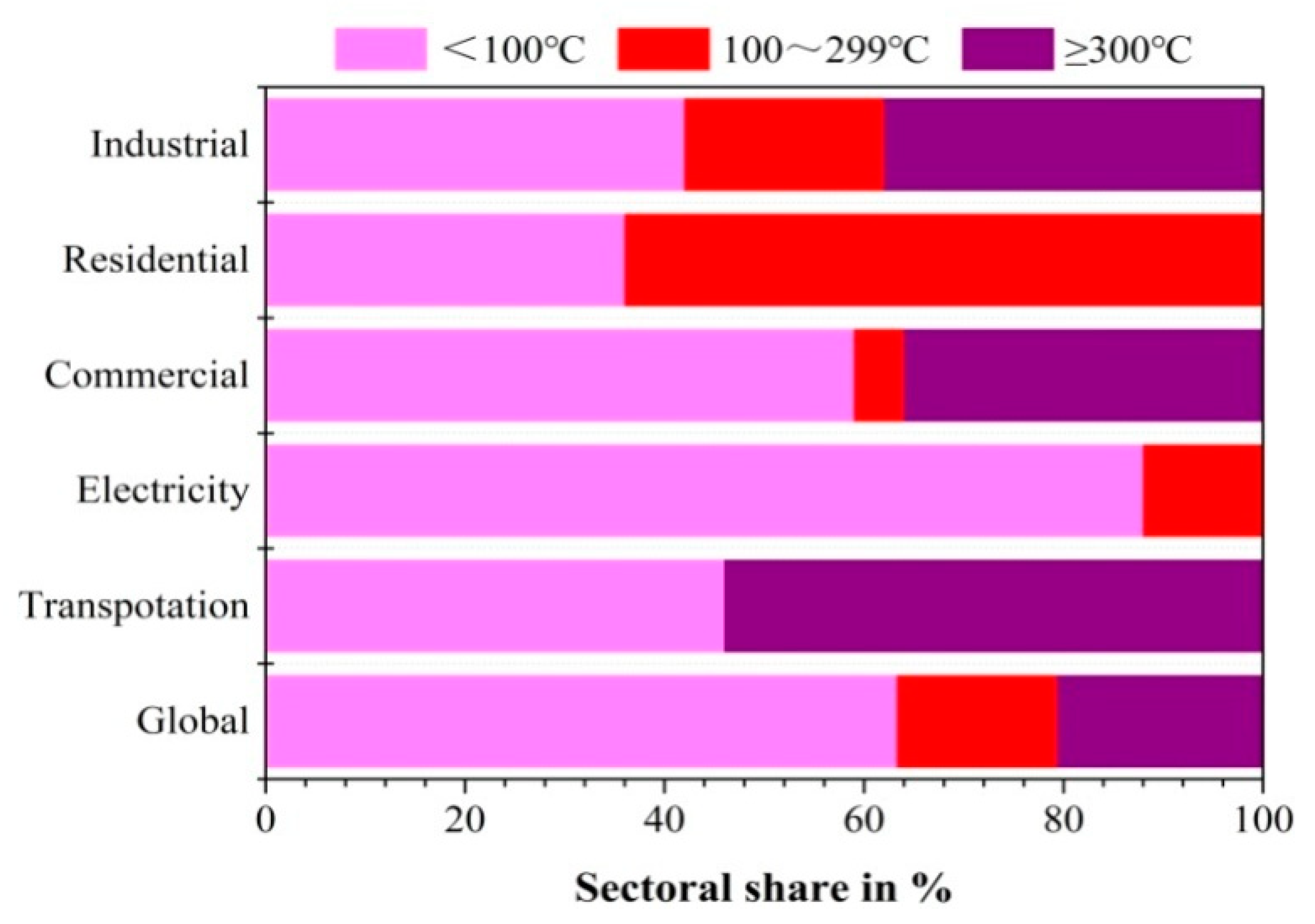

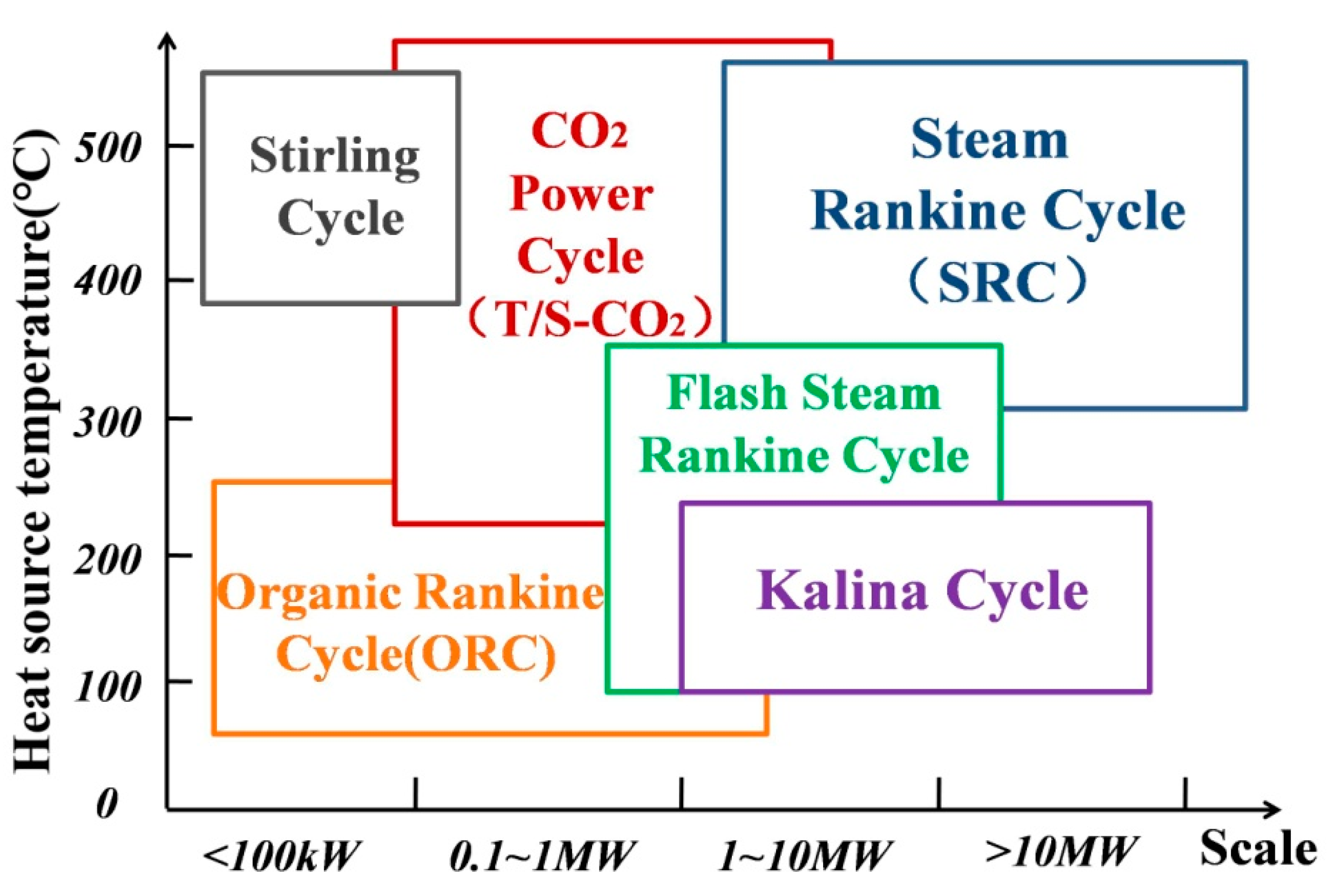
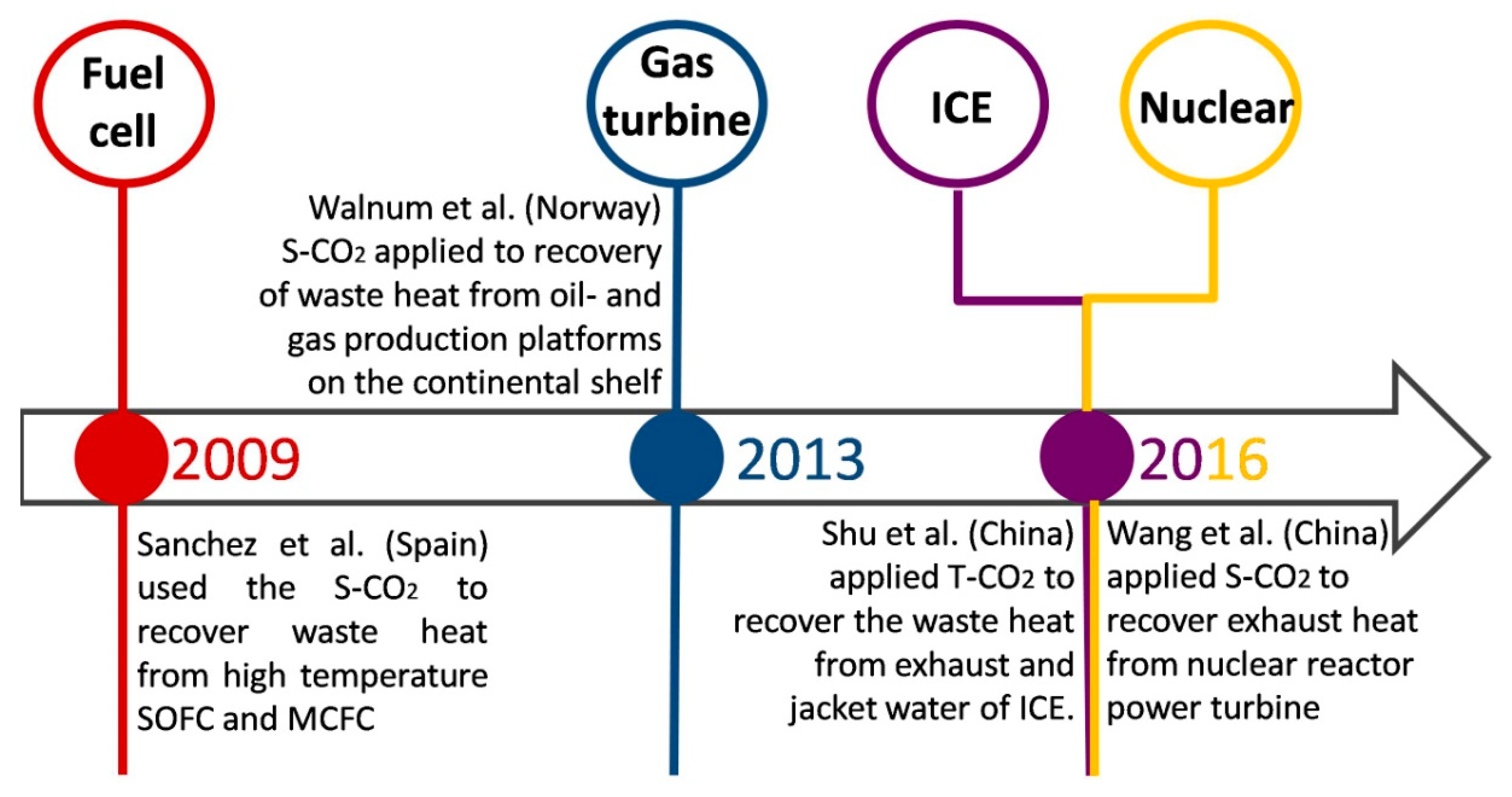
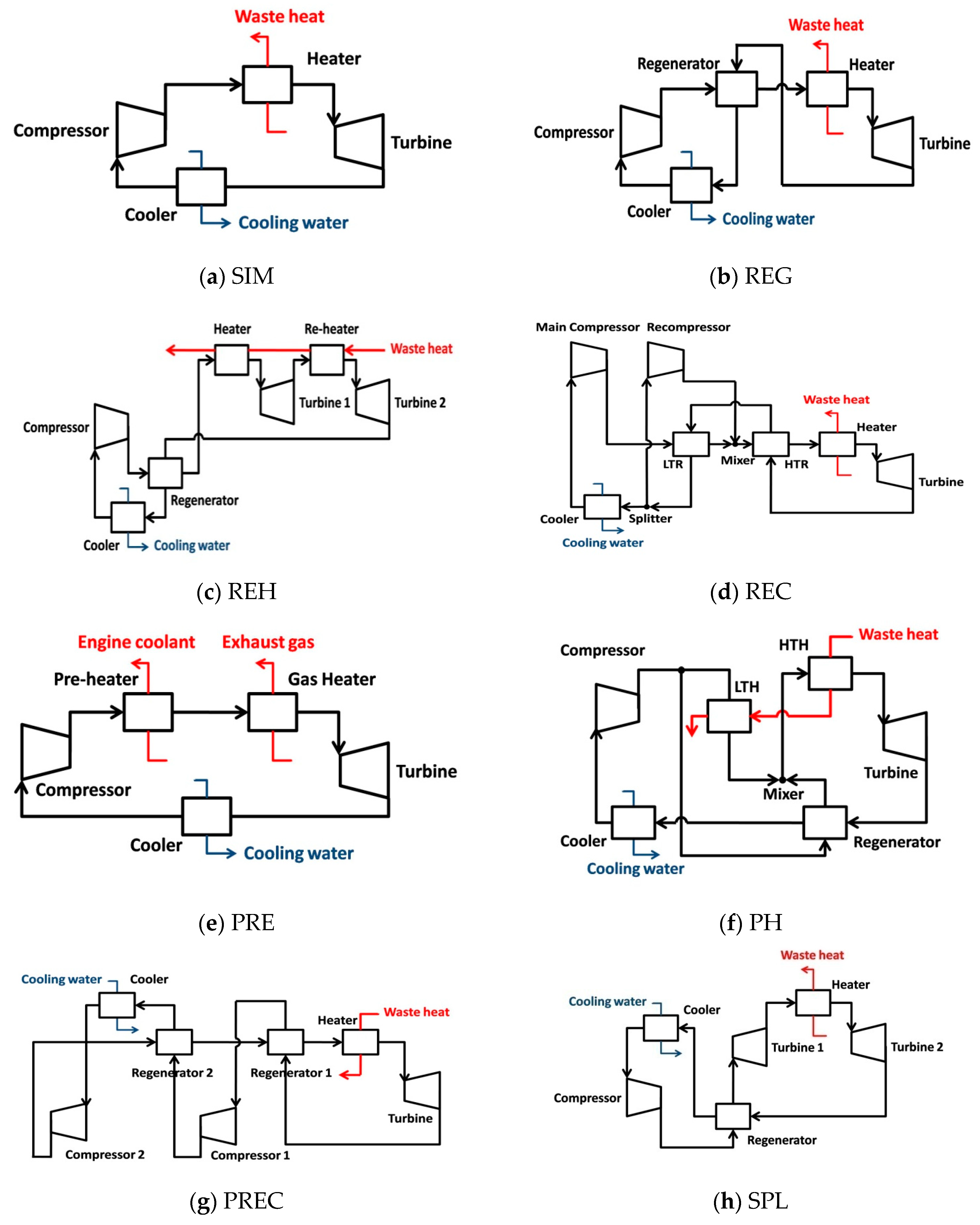
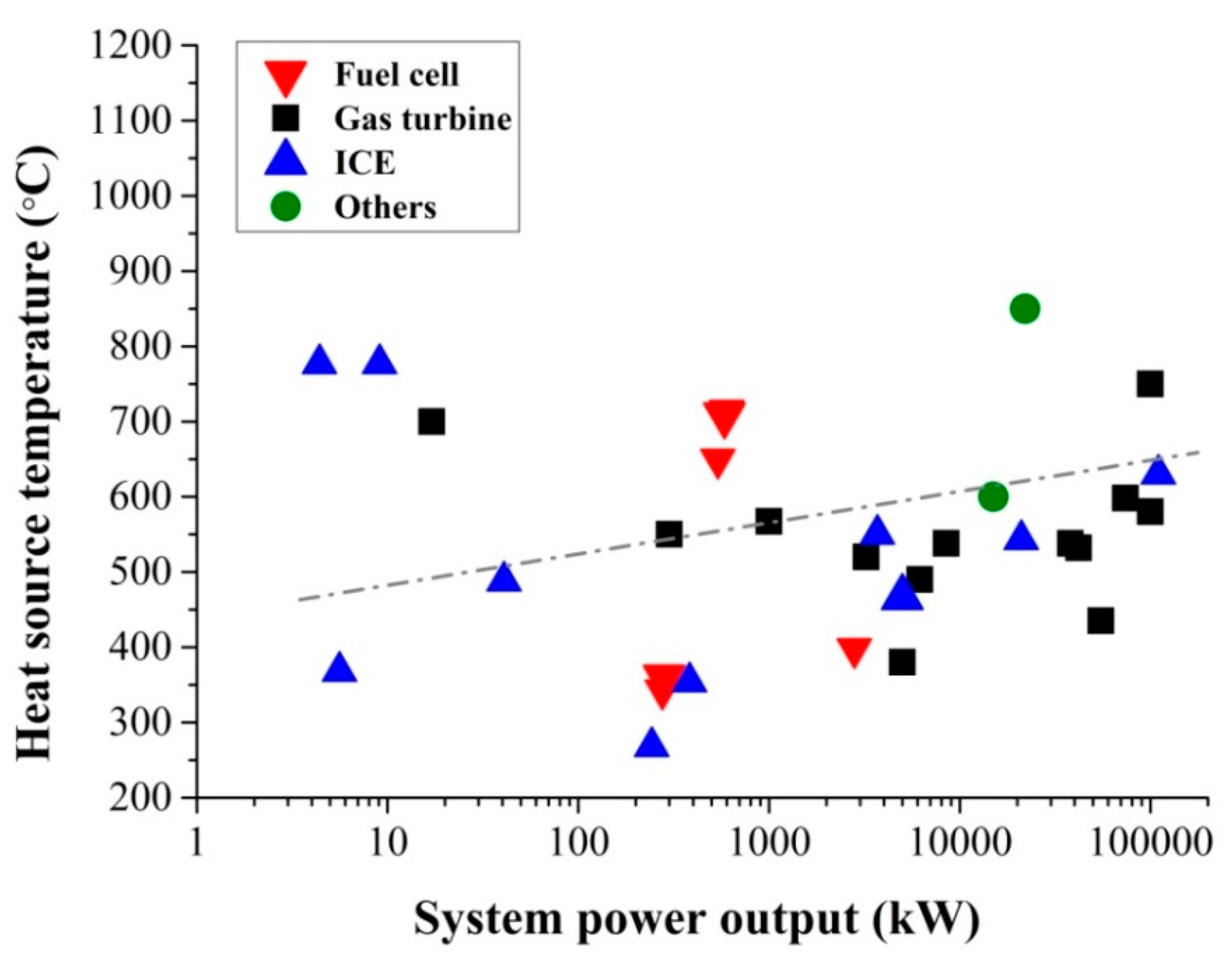
| Year | Author | Application | THS (°C) | Cycle Layouts | WCO2,net.max (kW) |
|---|---|---|---|---|---|
| 2009 | Sanchez et al. [40] | Fuel cell | 709 | REG | 583.6 |
| 2011 | Sanchez et al. [41] | Fuel cell | 650 | REG | 540.4 |
| 2013 | Walnum et al. [67] | Turbine | 532 | REG/ two stage REG | 41,100 42,000 |
| 2014 | Bae et al. [42] | Fuel cell | 709 | REC/REG/ two stage SIM | 600.8/582.8/ 603.8 |
| 2015 | Baronci et al. [43] | Fuel cell | 398 | REG | 2800 |
| 2015 | Moroz et al. [68] | Turbine | 425–700 | REG/REC/PREC/ cascade | 17.1 |
| 2015 | Cho et al. [69] | Turbine | 580 | cascade/PH/PRE | >100,000 |
| 2016 | Ahmadi et al. [44] | Fuel cell | 343 | s-CO2+LNG | 276.1 |
| 2016 | Shu et al. [47] | ICE | 777 | SIM/PRE+REG | 3.6/4.4 |
| 2016 | Choi et al. [57] | ICE | 354 | two stage REH | 383 |
| 2016 | Wang et al. [81] | Nuclear | 850 | two stage SIM | 22,000 |
| 2016 | Huck et al. [80] | Turbine | 650–750 | SPL | >100,000 |
| 2016 | Wright et al. [71] | Turbine | 538 | REG/PH/SPL | 8500 |
| 2016 | Kim et al. [72] | Turbine | 520 | RE/REC/PH/PREC/ various cascade cycles | 2180/2200/2750/2230 3230 |
| 2017 | Shu et al. [48] | ICE | 777 | SIM/PRE/REG/ PRE+REG | 3.7/5.5/4.6/ 9.1 |
| 2017 | Sharma et al. [58] | ICE | 368 | REG+REC | 5.6 |
| 2017 | Khadse et al. [73] | Turbine | 630 | REG/REC | 110,000 |
| 2017 | Cao et al. [74] | Turbine | 440–543 | REG+ORC | 21,000 |
| 2017 | Gao et al. [75] | Turbine | 538 | REG/REC/PH/cascade | 38,000 |
| 2018 | Tozlu et al. [76] | Turbine | 567 | REG | >1000 |
| 2018 | Zhang et al. [77] | Turbine | 490 | two stage SIM | 6170 |
| 2018 | Hou et al. [59] | ICE | 466 | REC+REF | 5000 |
| 2018 | Manjunath et al. [60] | ICE | 550 | two stage s-CO2/t-CO2 | 3694 |
| 2018 | Astolfi et al. [82] | Generic WHR | 200–600 | SIM/REG/REC | 15,000 |
| 2019 | Liang et al. [61] | ICE | 423–488 | REG+ORC(R1233zdE) | 40.9 |
| 2019 | Olumayegun et al. [83] | Turbine | 380 | REG+REC | 5000 |
| 2019 | Luo et al. [84] | Turbine | 500 | SIM+REF | --- |
| 2019 | Tao et al. [80] | Turbine | 550 | REG+REC | 300 |
| 2019 | Sanchez et al. [78] | Turbine | 598 | PH | 74,000 |
| 2020 | Ryu et al. [46] | Fuel cell | 360 | REC/REC+REH | 281.6/282.6 |
| 2020 | Feng et al. [62] | ICE | 268 | SIM+Kalina | 242.6 |
| 2020 | Liang et al. [63] | ICE | 380 | SIM+REF | 16.5 |
| 2020 | Pan et al. [64] | ICE | 557 | SIM+REF | 20.8 |
| 2020 | Zhang et al. [65] | ICE | 450 | REC | 39.5 |
| 2020 | Song et al. [66] | ICE | 460 | SIM+ORC | 215 |
| 2020 | Zhou et al. [79] | Turbine | 435 | two stage s-CO2/t-CO2 | 55,000 |
Publisher’s Note: MDPI stays neutral with regard to jurisdictional claims in published maps and institutional affiliations. |
© 2020 by the authors. Licensee MDPI, Basel, Switzerland. This article is an open access article distributed under the terms and conditions of the Creative Commons Attribution (CC BY) license (http://creativecommons.org/licenses/by/4.0/).
Share and Cite
Liu, L.; Yang, Q.; Cui, G. Supercritical Carbon Dioxide(s-CO2) Power Cycle for Waste Heat Recovery: A Review from Thermodynamic Perspective. Processes 2020, 8, 1461. https://doi.org/10.3390/pr8111461
Liu L, Yang Q, Cui G. Supercritical Carbon Dioxide(s-CO2) Power Cycle for Waste Heat Recovery: A Review from Thermodynamic Perspective. Processes. 2020; 8(11):1461. https://doi.org/10.3390/pr8111461
Chicago/Turabian StyleLiu, Liuchen, Qiguo Yang, and Guomin Cui. 2020. "Supercritical Carbon Dioxide(s-CO2) Power Cycle for Waste Heat Recovery: A Review from Thermodynamic Perspective" Processes 8, no. 11: 1461. https://doi.org/10.3390/pr8111461
APA StyleLiu, L., Yang, Q., & Cui, G. (2020). Supercritical Carbon Dioxide(s-CO2) Power Cycle for Waste Heat Recovery: A Review from Thermodynamic Perspective. Processes, 8(11), 1461. https://doi.org/10.3390/pr8111461




